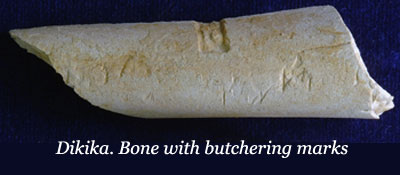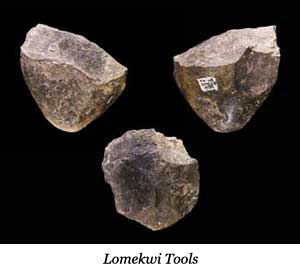
The First Stone Tools?
Ever since the scientific study of human origins began in the nineteenth century it had been assumed that our distinguishing characteristics were an increase in the size of our brains, our ability to walk on our 'hind' feet, and our ability to manufacture and use tools and it was assumed that they happened in that order. All of these assumptions have been challenged in the last century. The discovery of Australopithecus africanus in 1924 showed that early hominin species were walking upright long before their brains began to enlarge. Ninety years later it became apparent that similar creatures were quite capable of making tools for themselves.
In 201o, fossil animal bones bearing cut marks made by stone tools were found at Dikika, a site in the Afar region of Ethiopia, and dated to some  3.3 million years ago. No hominin remains were found at the site and only A. afarensis fossils were found in the region at this time so they are the most likely candidates. No actual tools were found at Dikika but they did turn up at Lomekwi 3 on the western shore of Lake Turkana (Kenya). Cobbles of stone can be battered by the natural forces of wind, water and gravity, but the fracture patterns do not suggest that that was the case here. Chimpanzees are well-known to have bashed stones together using a ‘hammer and anvil’ technique to break open nuts, creating fracture patterns. The Lomekwi finds, however primitive they may seem, give every impression of having been deliberated flaked and shaped, rather than simply bashed about by river action or having been randomly used in percussive activities.
3.3 million years ago. No hominin remains were found at the site and only A. afarensis fossils were found in the region at this time so they are the most likely candidates. No actual tools were found at Dikika but they did turn up at Lomekwi 3 on the western shore of Lake Turkana (Kenya). Cobbles of stone can be battered by the natural forces of wind, water and gravity, but the fracture patterns do not suggest that that was the case here. Chimpanzees are well-known to have bashed stones together using a ‘hammer and anvil’ technique to break open nuts, creating fracture patterns. The Lomekwi finds, however primitive they may seem, give every impression of having been deliberated flaked and shaped, rather than simply bashed about by river action or having been randomly used in percussive activities.
Nearly 150 pieces were recovered of which the majority were cores (83) or flakes (35). Of the rest, there were some that may have been used as hammers with others possibly served as anvils. The stone, predominantly basalts and phonolites, probably all came from a conglomerate located only 100 metres away and none of it had moved very far in the last 3½ million years. The cores are large and hefty compared to the much later samples from Olduvai Gorge, and average a little over 3 kilograms. Flakes had a wider range in size (c. 20-200 mm) and were much thinner on average. Anvils were very large and heavy, 30 kilos or more, and the upper surface was generally flat. The flakes were struck off the core using either the ‘passive hammer’ technique, whereby they were bashed against a heavy stone anvil, or the bipolar method, which involved placing the core on the anvil and then striking the opposite end with a hammer.
some that may have been used as hammers with others possibly served as anvils. The stone, predominantly basalts and phonolites, probably all came from a conglomerate located only 100 metres away and none of it had moved very far in the last 3½ million years. The cores are large and hefty compared to the much later samples from Olduvai Gorge, and average a little over 3 kilograms. Flakes had a wider range in size (c. 20-200 mm) and were much thinner on average. Anvils were very large and heavy, 30 kilos or more, and the upper surface was generally flat. The flakes were struck off the core using either the ‘passive hammer’ technique, whereby they were bashed against a heavy stone anvil, or the bipolar method, which involved placing the core on the anvil and then striking the opposite end with a hammer.
The tool-makers were not the most adept stone workers and there was a lot of wastage, but it is clear that there was some planning and foresight involved as well as a certain amount of manual dexterity. The Lomekwi finds show that these characteristics were already present well before Homo habilis and the Oldowan industry.
Suggested Reading
| Harmond, S, et. al. | (2015) | ‘3.3-million-year-old stone tools from Lomekwi 3, West Turkana, Kenya’. Nature 521 |
